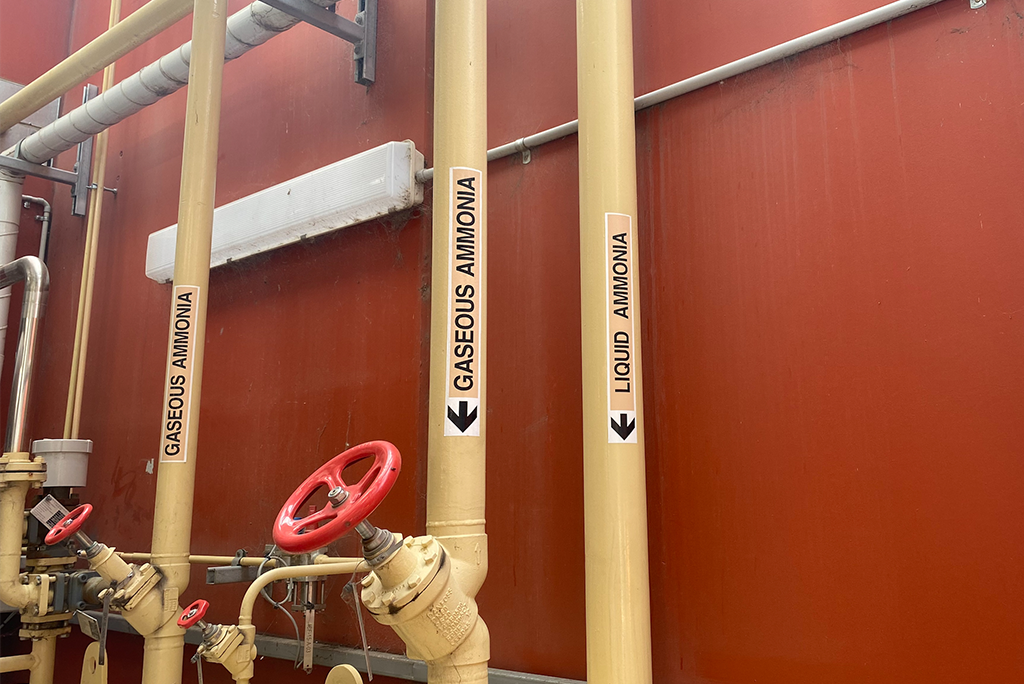If you have an operating industrial refrigeration system of any sort, chances are you are utilising Ammonia in some fashion. As it stands, Ammonia or what we call R717, is one of the most widely used chemicals on the planet and it needs to be well-managed.
Nevertheless, depending on the dose and means of exposure, this substance can cause immediate burning of the eyes, nose, throat, and respiratory tract – and in worse-case scenarios, can result in blindness, lung damage, or in very severe cases, death.
So, how do you strike a happy medium? Gain all the refrigeration benefits without sacrificing a safe workplace?
Pressure equipment compliance and corrosion:
The absolute number one rule with any refrigeration system is to guarantee the integrity of the pressure vessels and pipework. Inspections and repairs to paintwork should be robust and frequent – along with calibration and testing of safety shutdown systems.
Detection and warning systems:
It’s important to have both explosion level and toxicity monitoring in all areas where Ammonia may cause harm to capture an accurate reading and provide external visibility. In addition, gas detection is a safety critical system, and like other safety shutdown systems it has several interdependent control functions that need to be regularly calibrated and proven.
Ventilation – keep your area fresh and clean:
Having sufficient air dilution is a must for removing machine heat and preventing the accumulation of toxic and flammable gasses, but the discharge must not harm anyone.
During even a minor release, Ammonia may cause panic. So, get the exhaust outlets as high as practically possible or dump into a dispersion tank or scrubber to protect on-site personnel.

Make sure you’re properly supported:
An Ammonia system is a highly engineered product, but like most things, it won’t last forever. Eventually, spare parts and technical support will be needed and when the time comes will you have a competent crew that makes the process seamless?
Be prepared:
During an emergency, even the most responsive teams take time to get on-site and solve the issue at hand. This is why having an effective Ammonia-Specific Emergency Response Plan is critical to risk reduction and business recovery.
Asset and maintenance management is key:
The position of “run it till it fails” does have some short-term financial benefits. But if we’re talking long-term, sustainability and efficiency, a bespoke maintenance and condition monitoring program is a must.
Make sure your people are well-trained:
Ensuring your staff are properly trained and contractors are competent is critical to the success of your plant. It’ll help ensure the plant is in an optimal condition not to mention energy efficient and compliant.
Have clear signs and labelling:
Even the most experienced technician or engineer can get caught up tracing pipework. The more process flow identification and instrumentation diagrams in place the more efficiently your plant will be serviced.

Keep it clean:
Keeping your equipment clean and tidy is a sure-fire way to boost reliability and life cycle of the part. Organised plants are easily serviced and a clear way to demonstrate a commitment to maintaining safe equipment. Similarly, maintaining internal cleanliness of the plant is vital to longevity.
“Having the most accomplished and resourced emergency response team on the planet is fantastic, but logically, trying to chase a beast that’s bolted isn’t the most ideal solution. Managing the hazard while it’s still controlled is a much more intelligent practice,” says Oomiak’s WHS Manager Paddy Durham.
Bonus Tips:
Anhydrous Ammonia is a naturally occurring substance that when used correctly, has superior refrigerant qualities. Aside from delivering long-term cost savings and performance, its number one attribute is that it is self-warning. Ideally, we don’t want to smell it, so here are five key considerations to implement for a safer facility.
- Rule one: Keep on top of corrosion – always
- Calibrate and test your safety shutdown systems annually
- Ensure your gas detectors offer control and early warning functions
- Provide Awareness training to enhance safety and meet best practice
- Collaborate an emergency response plan with your service provider and fire service; test it regularly to achieve true resilience
As is evident, the processes of Ammonia risk management must be underpinned by a consistent focus on physicochemical and safety-critical awareness. Ammonia can be a great asset in your refrigeration dependent operation, get in touch or call us 1300 731 699 for some help on the how!



